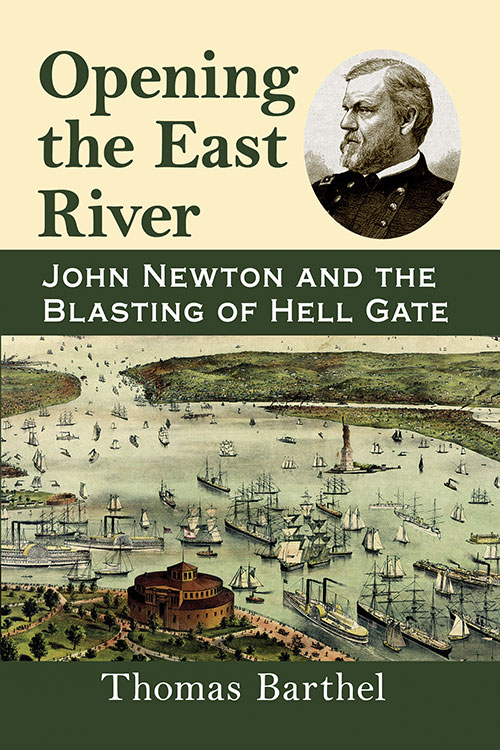Opening the East River
John Newton and the Blasting of Hell Gate
Original price was: $39.95.$19.99Current price is: $19.99.
In stock
About the Book
After the Civil War, the New York City’s East River was a massive unsolved and dangerous navigation problem. A major waterway into and out of the Harbor—where customs revenue equaled 42 percent of the U.S. Government’s income—the river’s many hindrances, centered around Hell Gate, included whirlpools, rocks and reefs. These, combined with swirling currents and powerful tides, led to deaths, cargo losses and destruction of vessels. Charged with clearing the river, General John Newton of the Army Corps of Engineers went to work with the most rudimentary tools for diving, mining, lighting, pumping and drilling. His crews worked for 20 years, using a steam-drilling scow of his own design and a new and perilous explosive—nitroglycerine. In 1885, Newton destroyed the nine-acre Flood Rock with 282,730 pounds of high explosives. The demolition was watched by tens of thousands. This book chronicles the clearing of the East River and the ingenuity of the Army engineer whose work was praised by the National Academy of Sciences.
About the Author(s)
Bibliographic Details
Thomas Barthel
Format: softcover (6 x 9)
Pages: 236
Bibliographic Info: 31 photos, notes, bibliography, index
Copyright Date: 2021
pISBN: 978-1-4766-8298-3
eISBN: 978-1-4766-4326-7
Imprint: McFarland
Table of Contents
Preface 1
Introduction 3
One. A City of Islands 5
Travel on Land 6
New York, a Maritime City 7
The Sandy Hook Problem 8
The East River Passage 9
Fulton on the Hudson 10
Clinton’s Ditch 12
Shipbuilding, Commerce and New York City 14
Famed Ships and Shipbuilders 14
Two. The Business of the City 18
Some Studies Are Begun 18
The Channels of the East River 19
From Throgs Neck to Little Hell Gate 20
Little Hell Gate 20
Hallet’s Point Reef 21
Changes in Ships and Ship Building 23
The First Glimmer of Funds 25
Coasters 25
Maillefert at Work 28
The Politics of Funding 29
Three. General Newton Takes Command 31
Newton Is Chosen 33
The City Changes 36
Ferries, Pilots, and The News 37
Newton Designs the Projects 39
Some Solutions, Some Problems 44
Newton Includes Nitroglycerin 45
Four. Newton’s Needs 47
Planning and Progress 47
Hazards and Virtues of Nitroglycerine 50
The East River Association 52
At Work with Sidney Shelbourne and Benjamin S.H. Maillefert Again 56
The Case of the Thatcher Magoun 59
Work Begins on the Reef at Hallet’s Point 61
Five. Newton Adapts 64
The First Steps 64
Ships and Vanderbilt’s Trains 66
Dockage and Piers 67
Despite Nitroglycerine’s Deadly Accidents Newton Trusts It 68
Newton’s Confidence 70
Six. Newton’s Marvelous Machine 73
The Creation of Newton’s Steam Drilling Scow 73
Nitroglycerine Is Studied 77
The Handling, Transportation and Storage of Nitroglycerine 78
Newton Adapts to the Steam Drill 79
The Railroads Show Their Promise 80
Hallet’s Point Reef: The Tools and the Workers 81
Interested Parties 82
The Danger Remains; the Funds Arrive 83
Seven. The Scow at Work 86
Progress with Some Obstacles in the River 86
Changes in Ships Verify Newton’s Work on the River 87
The Importance of Julius H. Striedinger 88
Newton’s Refining of the Scow’s Operations 88
The Accidents Continue and the Tunnels Move Under the River 90
Improvements in Steam Drills and Other Tools 91
Eight. The Long Depression Begins 95
The Work Goes On Even as the Appropriations Fall Short 95
Newton’s Additional Duties on the Hudson as the Economy Crashes 96
Advantages and Dangers of Nitroglycerine 98
Divers and the Positioning of Explosives 99
Changes and Adaptations in American Shipping 101
Hallet’s Point Reef Preparation Continues 102
Newton’s Jurisdiction Extends into Vermont 103
Explosives, Fuses and Continuing Dangers 103
The Newton Steam Drilling Scow at Work 107
Changes in Newton’s Plan 108
Two Rocks and a Reef: The Frying Pan, Way’s Reef, and Pot Rock 110
Spuyten Duyvel and the Harlem River 110
Up and Down the River 113
Close to the Finish 114
Nine. Newton’s Many Plans 118
The Country Is Attentive 118
Hallet’s Point Reef 119
A Decision on Explosives 121
Making the Cartridges 123
Wiring the Cartridges 125
Connecting the Wires 127
The Danger Remained 129
The City Reacts 130
Ten. Newton’s Triumph of Science 133
The Crowds Assemble 133
Blast Time 139
Reaction and Judgment 140
Eleven. Newton’s Aim of 26 Feet 146
Newton’s Second Decade 146
Some Results 147
A Challenge 148
Newton’s Argument 148
Delays at Hell Gate 149
The New York Central 151
The Delays Go On 152
The Harlem River Studied Again 153
Twelve. Newton’s Work Slows 155
Newton’s Strategy 155
Progress at Flood Rock 156
Expanding the Site 159
Newton Considers 162
Interest Increases 164
Other Projects at the Same Time 165
The Working Force 167
Slowdown of 1882–1883 167
Newton in Charge 169
Thirteen. Newton Readies the Explosion 172
Strategies Are Decided 172
Preparing the Cartridges 176
Installing the Cartridges 178
The Guests and the Police 179
Explosions Explained 180
Fourteen. Newton’s Violent Triumph 182
Saturday Night Preparations Before the Sunday Blast 182
Sunday Morning’s Tasks 183
Blast Time 186
Newton Arrives at the Firing Point 187
After the Blast 190
Estimates of Work to Be Done 193
Some Measurements of the Explosion 194
Fifteen. Newton’s Last Decade 195
Death 196
Honors 196
A Gazetteer of the East River Obstructions 201
Chapter Notes 207
Bibliography 215
Index 225
Book Reviews & Awards
• “Useful history of submarine clearance of New York City waterways…provides clear reproductions of illustrations and maps from contemporary journals and newspapers. I recommend this book for those interested in the history of underwater engineering, as well as the commercial and maritime history of New York City.”—Sea History
• “In a not insubstantial way, this book serves to memorialize the men who made the East River a little safer, and who helped to ensure the continued financial well-being of a growing nation…A handy overview for a complex internal improvement project, this book will sit comfortably on most any bookshelf.”—The Northern Mariner





